1990 VOLKSWAGEN TRANSPORTER engine
[x] Cancel search: enginePage 9 of 165
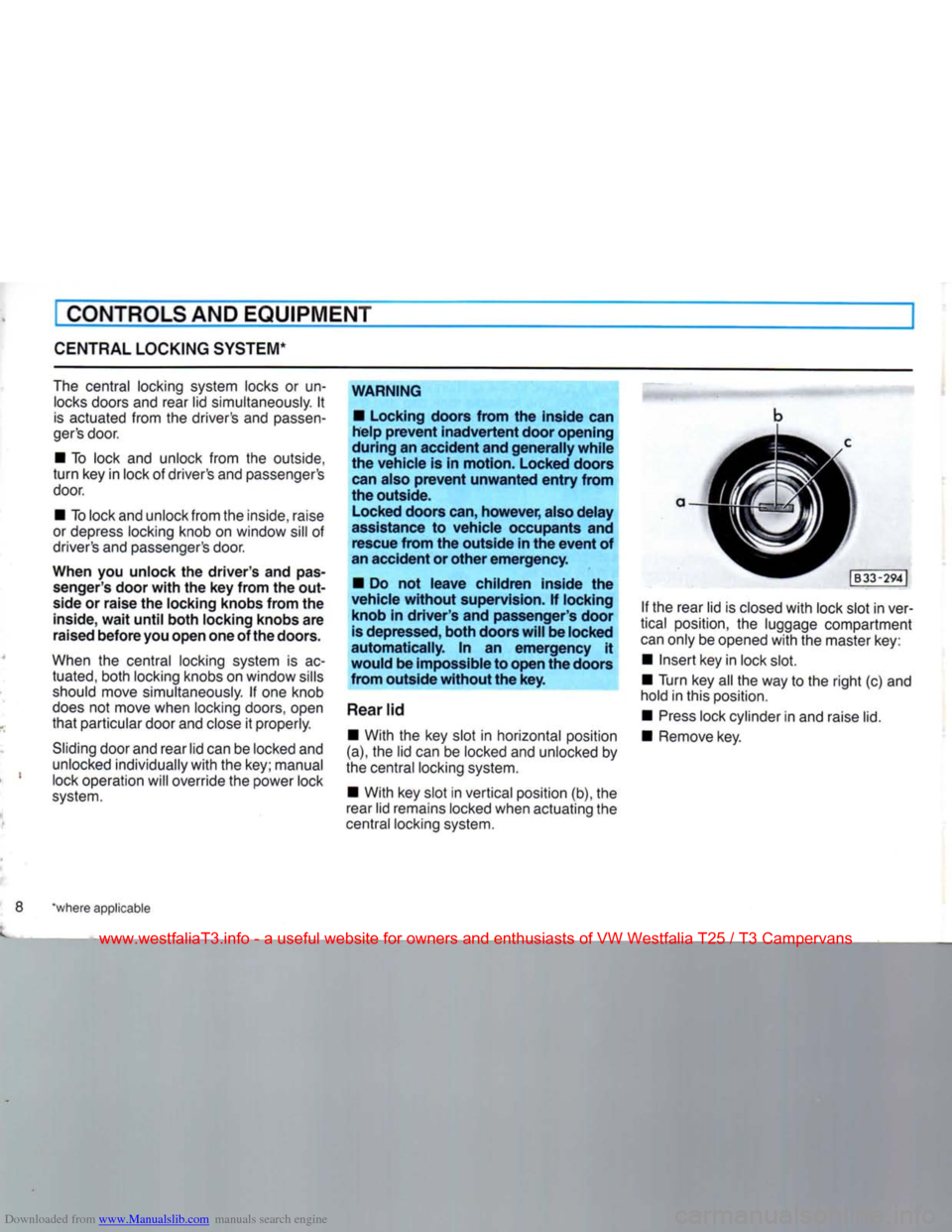
Downloaded from www.Manualslib.com manuals search engine
CONTROLS AND EQUIPMENT
CENTRAL
LOCKING SYSTEM*
The
central locking system locks or un
locks
doors and rear lid simultaneously. It
is
actuated from the driver's and
passen
ger's
door.
• To lock and unlock from the outside,
turn
key in lock of driver's and passenger's
door.
• To lock and unlock from the inside, raise
or depress locking knob on window sill of
driver's and passenger's door.
When
you unlock the
driver's
and pas senger's door
with
the key
from
the
out
side or
raise
the locking knobs
from
the inside,
wait
until
both
locking knobs are
raised
before
you open one of the doors.
When
the central locking system is ac tuated, both locking knobs on window sills
should
move simultaneously. If one knob
does
not move when locking doors, open
that
particular door and close it properly.
Sliding
door and rear lid can be locked and
unlocked
individually
with
the key; manual lock operation will override the power lock
system.
WARNING
• Locking doors
from
the inside can
help
prevent
inadvertent
door opening
during
an
accident
and
generally
while
the
vehicle
is in
motion.
Locked doors can also
prevent
unwanted
entry
from
the outside.
Locked doors can,
however,
also
delay
assistance to
vehicle
occupants and rescue
from
the
outside
in the
event
of
an
accident
or
other
emergency.
• Do not
leave
children
inside the
vehicle
without
supervision. If locking
knob
in
driver's
and passenger's door is depressed,
both
doors
will
be locked
automatically.
In an
emergency
it
would
be impossible to open the doors
from
outside
without
the key.
Rear
lid • With the key slot in horizontal position
(a), the lid can be locked and unlocked by
the central locking system.
• With key slot in vertical position (b), the
rear lid remains locked when actuating the
central locking system. If the rear lid is closed
with
lock slot in ver
tical position, the luggage compartment
can
only be opened
with
the master key:
• Insert key in lock slot.
• Turn key all the way to the
right
(c) and
hold in this position.
•
Press
lock cylinder in and raise lid.
• Remove key.
'where applicable
www.westfaliaT3.info - a useful website for owners and enthusiasts of VW Westfalia T25 / T3 Campervans
Page 10 of 165
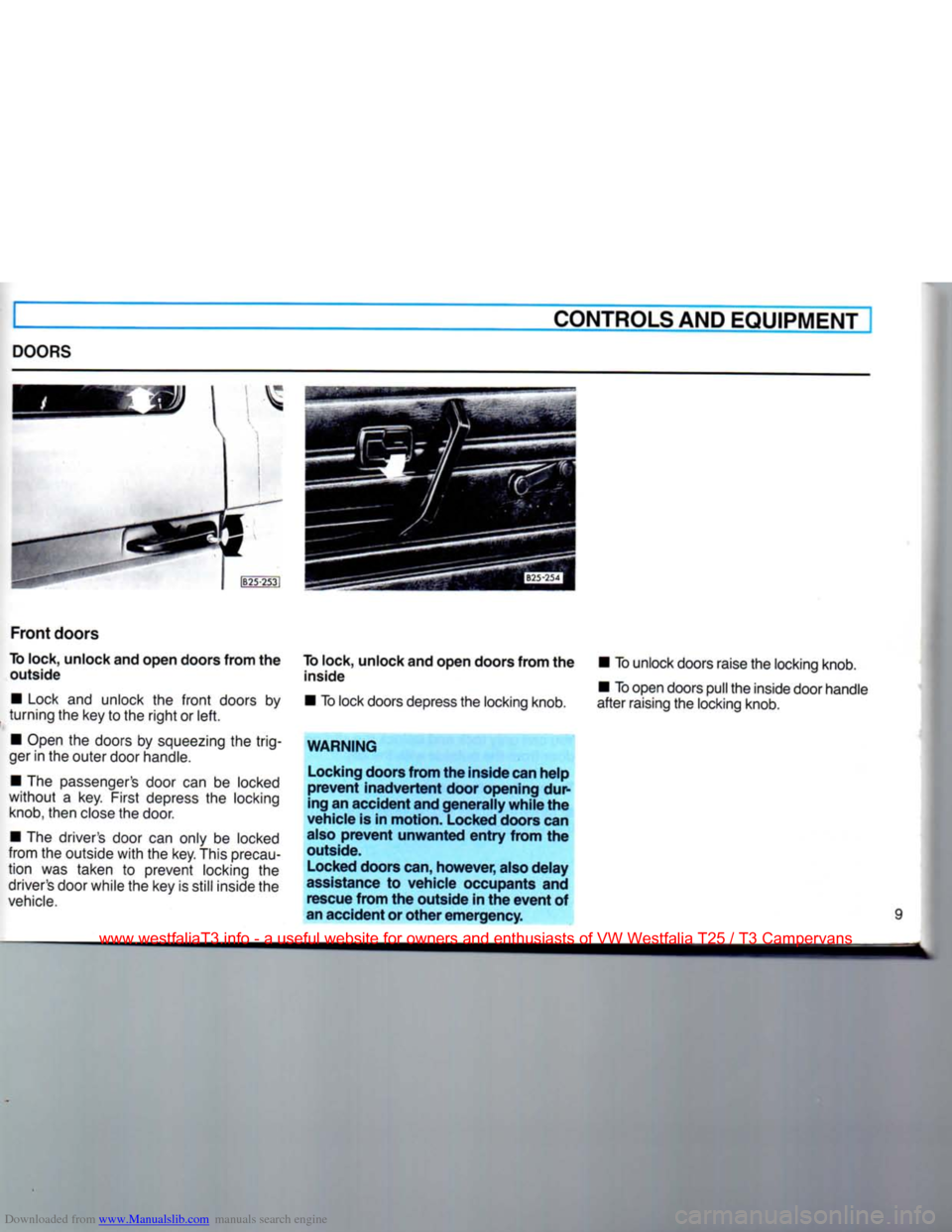
Downloaded from www.Manualslib.com manuals search engine
CONTROLS AND
EQUIPMENT
DOORS
Front
doors
To
lock, unlock and open doors from the outside
• Lock and unlock the
front
doors by
turning the key to the
right
or
left.
• Open the doors by squeezing the trig
ger in the outer door handle.
• The passenger's door can be locked
without
a key. First depress the locking knob, then close the door.
• The driver's door can only be locked
from the outside
with
the key. This precau
tion
was taken to prevent locking the driver's door while the key is still inside the
vehicle.
To
lock, unlock and open doors from the
inside
• To lock doors depress the locking knob.
WARNING
Locking doors
from
the
inside
can
help
prevent
inadvertent
door
opening
dur
ing an
accident
and
generally
while
the
vehicle
is in
motion.
Locked doors can
also
prevent
unwanted
entry
from
the
outside.
Locked doors can,
however,
also
delay
assistance to
vehicle
occupants and rescue
from
the
outside
in the
event
of
an
accident
or
other
emergency.
• To unlock doors raise the locking knob.
•
To
open doors pull the inside door handle
after raising the locking knob.
www.westfaliaT3.info - a useful website for owners and enthusiasts of VW Westfalia T25 / T3 Campervans
Page 11 of 165
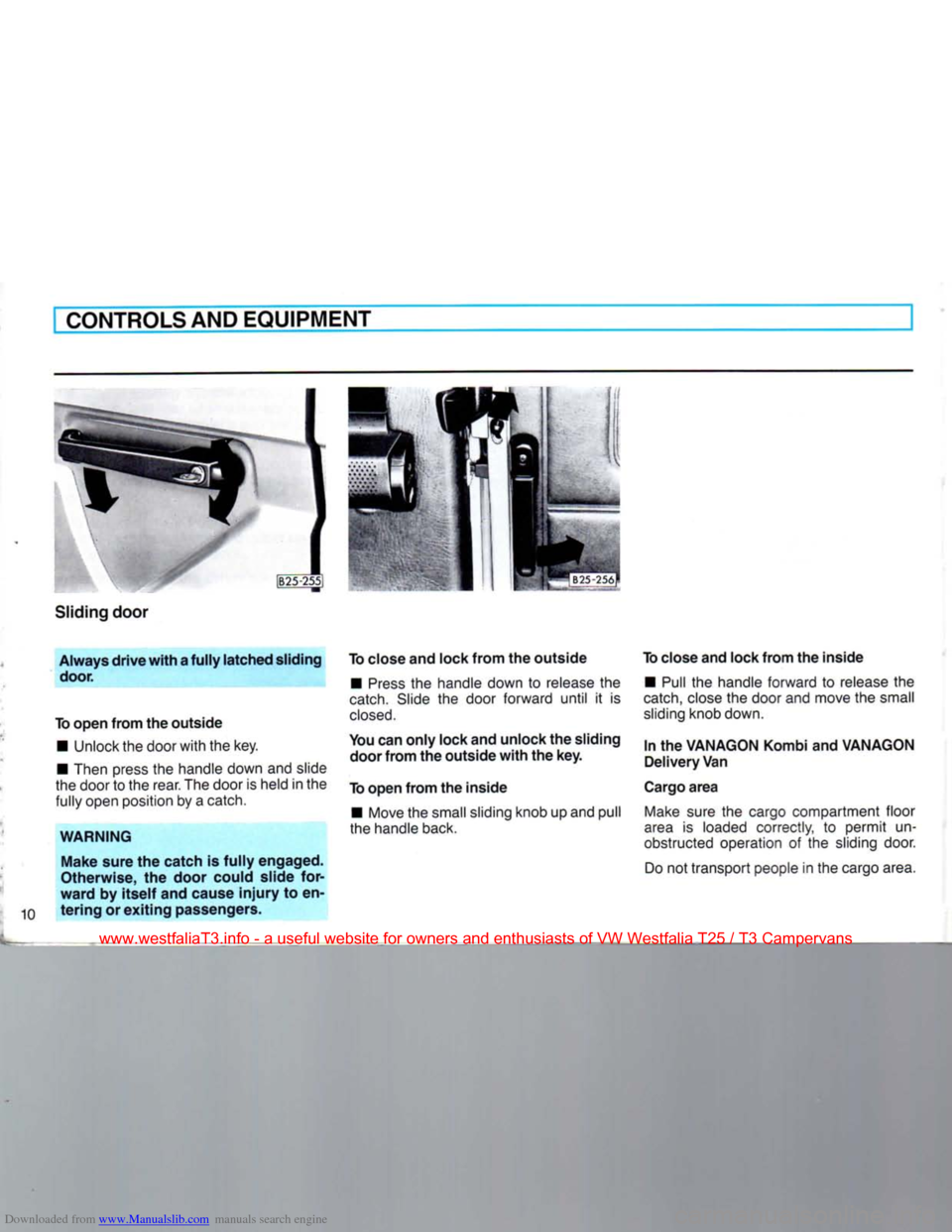
Downloaded from www.Manualslib.com manuals search engine
CONTROLS AND
EQUIPMENT
Sliding door
Always
drive
with
a
fully
latched
sliding door.
To
open
from
the
outside
• Unlock the door
with
the key.
• Then press the handle down and slide
the door to the rear. The door is held in the
fully open position by a catch.
WARNING
Make
sure
the
catch
is
fully
engaged.
Otherwise,
the door could slide
for
ward
by
itself
and cause
injury
to en
tering
or
exiting
passengers. To close and lock
from
the
outside
•
Press
the handle down to release the
catch.
Slide the door forward
until
it is
closed.
You can
only
lock and
unlock
the sliding door
from
the
outside
with
the key.
To
open
from
the
inside
• Move the small sliding knob up and pull
the handle back. To close and lock
from
the
inside
• Pull the handle forward to release the
catch,
close the door and move the small
sliding knob down.
In the VANAGON Kombi and VANAGON
Delivery
Van
Cargo
area
Make
sure the cargo compartment floor
area
is loaded correctly, to permit un
obstructed operation of the sliding door.
Do
not transport people in the cargo area.
www.westfaliaT3.info - a useful website for owners and enthusiasts of VW Westfalia T25 / T3 Campervans
Page 12 of 165
![VOLKSWAGEN TRANSPORTER 1990 T4 / 4.G Owners Manual Downloaded from www.Manualslib.com manuals search engine
CONTROLS
AND
EQUIPMENT]
REAR LID
10
unlock the rear lid, use
the
key
A.
•
Insert
key
into vertical lock slot position
and
t VOLKSWAGEN TRANSPORTER 1990 T4 / 4.G Owners Manual Downloaded from www.Manualslib.com manuals search engine
CONTROLS
AND
EQUIPMENT]
REAR LID
10
unlock the rear lid, use
the
key
A.
•
Insert
key
into vertical lock slot position
and
t](/manual-img/18/7415/w960_7415-11.png)
Downloaded from www.Manualslib.com manuals search engine
CONTROLS
AND
EQUIPMENT]
REAR LID
10
unlock the rear lid, use
the
key
A.
•
Insert
key
into vertical lock slot position
and
turn
to
left.
•
Press lock cylinder
in
and lift lid.
The open hatchback will stay
in
position
at
any desired height.
•
To
close, swing
lid
down.
•
Lock with
key.
Be
careful when loading
or
removing
large objects. Sharp edged articles
may damage the defogger wires in
the
rear window.
For safety reasons keep
the
rear
lid
locked
at
all
times. WARNING
To help
prevent
poisonous exhaust
gas from being drawn into the vehicle,
always keep the rear lid closed while
driving.
Do
not
transport objects larger than
those fitting safely into
the
luggage
area.
www.westfaliaT3.info - a useful website for owners and enthusiasts of VW Westfalia T25 / T3 Campervans
Page 13 of 165
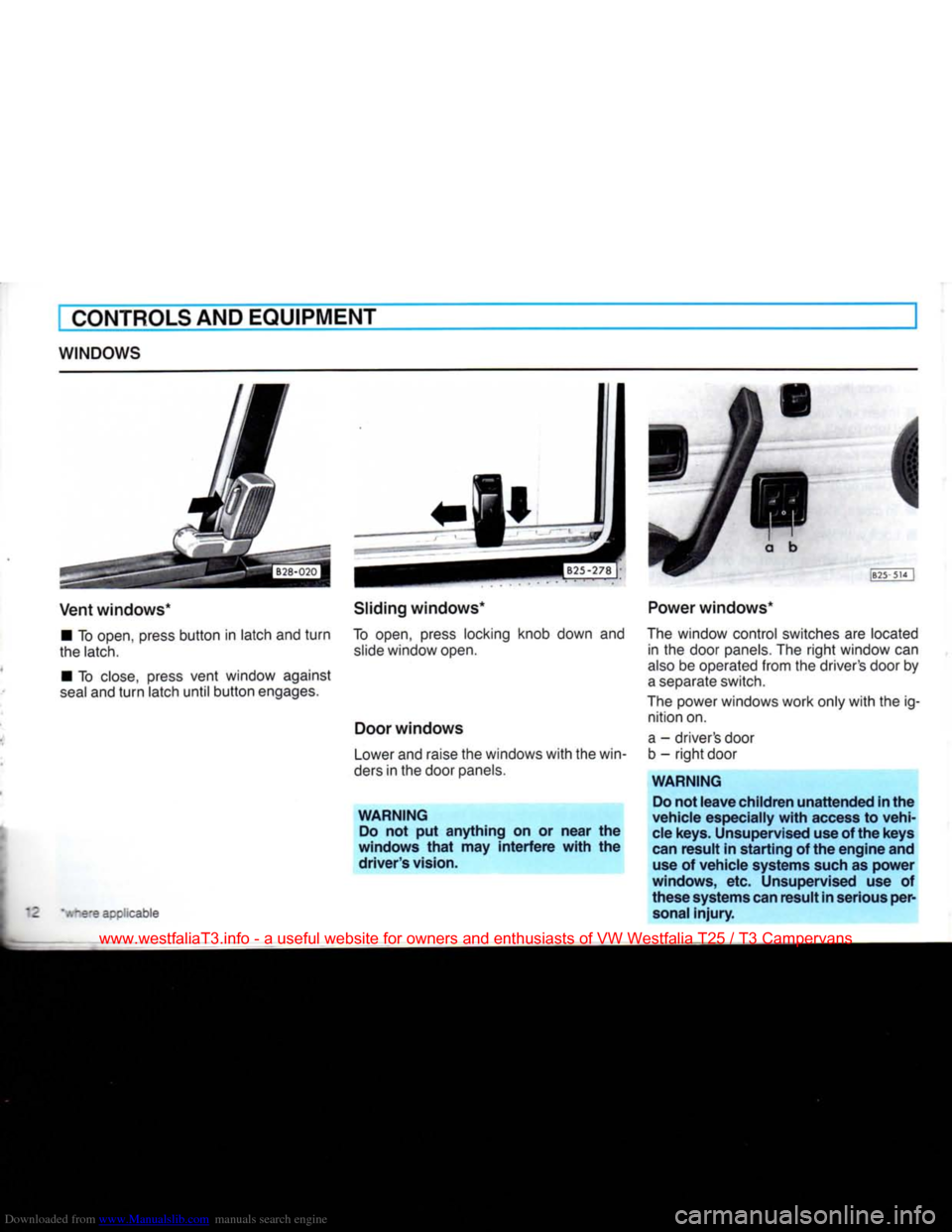
Downloaded from www.Manualslib.com manuals search engine
CONTROLS
AND EQUIPMENT
WINDOWS
Vent windows*
•
To
open,
press
button in latch and turn
the
latch.
•
To
close,
press
vent window
against
seal
and turn latch until button
engages.
Sliding
windows*
To
open,
press
locking
knob down and
slide
window
open.
Door
windows
Lower
and
raise
the windows with the
win
ders
in the
door
panels.
WARNING
Do
not put anything on or near the
windows
that
may
interfere
with
the driver's vision.
~s's
aco'icable
Power windows*
The
window control
switches
are
located
in
the
door
panels.
The right window can
also
be
operated
from the driver's
door
by
a
separate
switch.
The
power
windows work only with the ig
nition
on.
a
- driver's
door
b
- right
door
WARNING
Do
not leave children unattended in the
vehicle especially
with
access
to vehi
cle
keys. Unsupervised use of the keys
can
result in starting of the engine and
use
of vehicle systems such as power
windows, etc. Unsupervised use of
these systems can result in serious per
sonal
injury.
www.westfaliaT3.info - a useful website for owners and enthusiasts of VW Westfalia T25 / T3 Campervans
Page 14 of 165
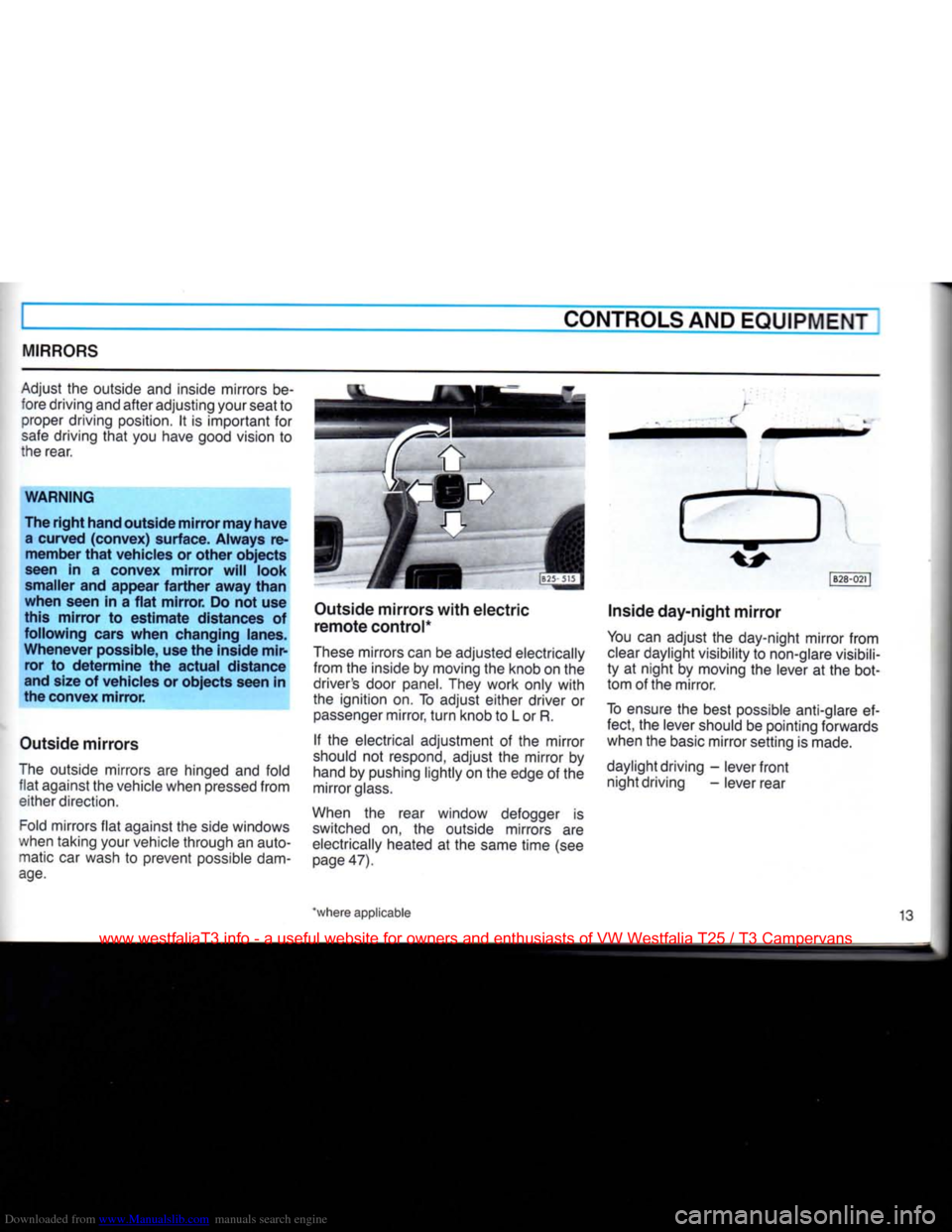
Downloaded from www.Manualslib.com manuals search engine
CONTROLS AND EQUIPMENT
MIRRORS
Adjust
the
outside
and
inside mirrors
be
fore driving and after adjusting your seat
to
proper driving position.
It is
important
for
safe driving that
you
have good vision
to
the rear.
WARNING
The right hand outside mirror may have a curved (convex) surface. Always remember that vehicles or other objects
seen in a convex mirror will look
smaller and appear farther away than
when seen in a flat mirror. Do not use
this mirror to estimate distances of
following cars when changing lanes.
Whenever possible, use the inside mir ror to determine the actual distance
and size of vehicles or objects seen in
the convex mirror.
Outside mirrors
The outside mirrors
are
hinged
and
fold flat against
the
vehicle when pressed from either direction.
Fold mirrors flat against
the
side windows
when taking your vehicle through
an
auto matic
car
wash
to
prevent possible dam
age.
Outside mirrors with electric
remote control*
These mirrors can
be
adjusted electrically from
the
inside
by
moving
the
knob
on the
driver's door panel. They work only with
the ignition
on. To
adjust either driver
or
passenger mirror, turn knob
to L or R.
If
the
electrical adjustment
of the
mirror
should
not
respond, adjust
the
mirror
by
hand
by
pushing lightly
on the
edge
of the
mirror glass.
When
the
rear window defogger
is
switched
on, the
outside mirrors
are
electrically heated
at the
same time
(see
page 47). |B28-021
|
Inside day-night mirror
You
can
adjust
the
day-night mirror from clear daylight visibility
to
non-glare visibili
ty
at
night
by
moving
the
lever
at the
bot
tom
of
the mirror.
To ensure
the
best possible anti-glare
ef
fect,
the
lever should
be
pointing forwards
when
the
basic mirror setting
is
made.
daylight driving
-
lever front night driving
-
lever rear
*where applicable 13
www.westfaliaT3.info - a useful website for owners and enthusiasts of VW Westfalia T25 / T3 Campervans
Page 15 of 165
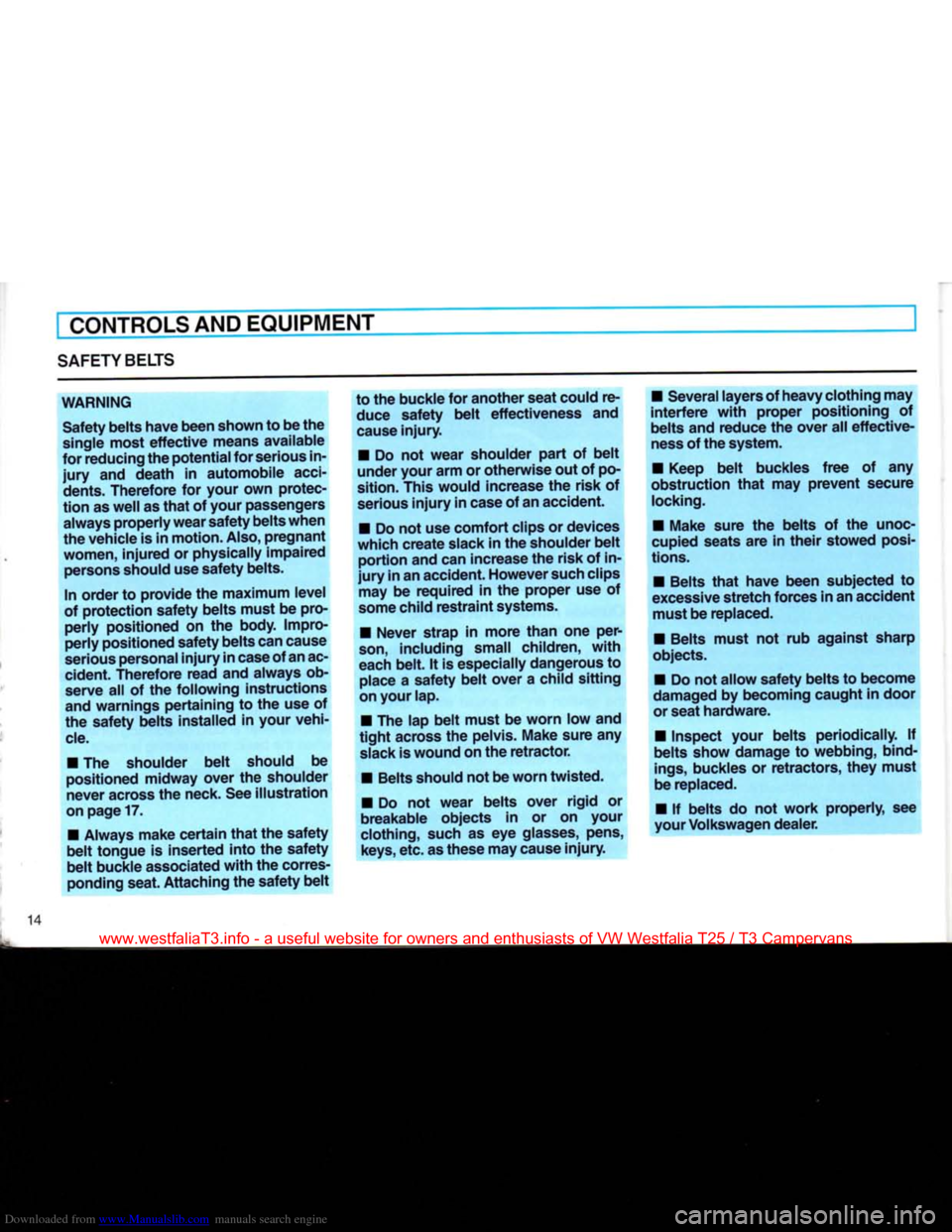
Downloaded from www.Manualslib.com manuals search engine
CONTROLS
AND
EQUIPMENT
SAFETY
BELTS
WARNING Safety belts have been shown to be the
single most effective means available
for reducing the
potential
for serious in
jury
and death in automobile
acci
dents.
Therefore
for
your
own protec
tion as well as that of
your
passengers always properly wear safety
belts
when
the vehicle is in
motion.
Also, pregnant
women,
injured or physically impaired persons should use safety belts.
In order to provide the maximum level
of protection safety belts must be pro perly positioned on the
body.
Impro
perly positioned safety belts
can
cause
serious personal
injury
in
case
of
an
ac
cident.
Therefore
read and always ob serve all of the following instructions
and warnings pertaining to the use of
the safety belts installed in
your
vehi
cle.
•
The shoulder belt should be
positioned midway
over
the shoulder
never
across the neck. See illustration
on page
17.
•
Always make certain that the safety
belt tongue is inserted into the safety
belt buckle associated with the corres
ponding seat. Attaching the safety belt to the buckle for another seat could re
duce safety belt effectiveness and
cause
injury.
•
Do not wear shoulder part of belt
under
your
arm
or otherwise out of po
sition.
This
would increase the risk of
serious
injury
in case of
an
accident.
•
Do not use comfort clips or devices
which create slack in the shoulder belt portion and can increase the risk of in
jury
in an accident.
However
such clips may be required in the proper use of
some
child restraint systems.
•
Never
strap in more than one per
son,
including
small
children, with
each
belt. It is especially dangerous to
place
a safety belt
over
a child sitting
on
your
lap.
•
The lap belt must be
worn
low and
tight across the pelvis. Make sure any
slack
is wound on the retractor.
•
Belts should not be
worn
twisted.
•
Do not wear belts
over
rigid or
breakable
objects in or on
your
clothing,
such as eye glasses, pens,
keys,
etc. as these may cause
injury.
•
Several layers of
heavy
clothing
may
interfere with proper positioning of
belts
and reduce the
over
all effective
ness
of the system.
•
Keep belt buckles free of any
obstruction that may
prevent
secure
locking.
•
Make sure the belts of the unoc
cupied seats are in their stowed posi
tions.
•
Belts that have been subjected to
excessive stretch forces in
an
accident must be replaced.
•
Belts must not rub against sharp
objects.
•
Do not allow safety belts to become
damaged
by becoming caught in door
or seat hardware.
•
Inspect
your
belts periodically. If
belts
show damage to webbing, bind
ings,
buckles or retractors,
they
must
be replaced.
•
If belts do not work properly, see
your
Volkswagen dealer.
www.westfaliaT3.info - a useful website for owners and enthusiasts of VW Westfalia T25 / T3 Campervans
Page 16 of 165
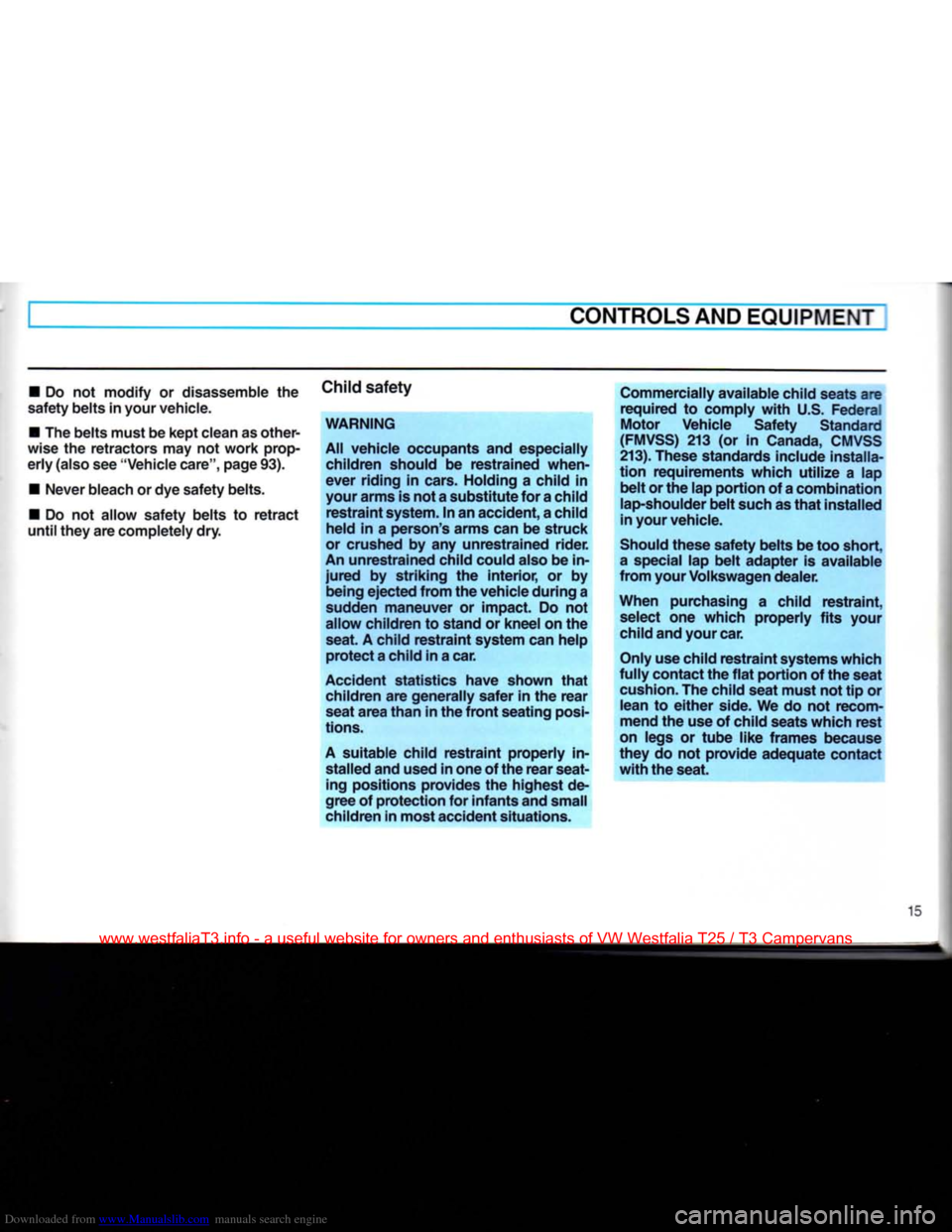
Downloaded from www.Manualslib.com manuals search engine
CONTROLS
AND
EQUIPMENT
• Do not modify or disassemble the
safety belts in
your
vehicle.
• The belts must be kept clean as other
wise the retractors may not work prop
erly
(also see "Vehicle care", page 93).
•
Never
bleach or dye safety belts.
• Do not allow safety belts to retract
until
they
are completely dry. Child safety
WARNING
All
vehicle occupants and especially children should be restrained when
ever
riding in cars. Holding a child in
your
arms is not
a
substitute for
a
child restraint system. In an accident,
a
child
held in a person's arms can be struck
or crushed by any unrestrained rider.
An unrestrained child could also be in
jured
by striking the interior, or by
being
ejected from the vehicle during a
sudden maneuver or impact. Do not
allow children to stand or kneel on the
seat.
A child restraint system can help protect
a
child in
a
car.
Accident statistics have shown that children are generally safer in the rear
seat area than in the
front
seating posi
tions.
A suitable child restraint properly in
stalled
and used in one of the rear seat
ing
positions provides the highest de
gree of protection for infants and
small
children in most accident situations. Commercially available child seats are
required to comply with U.S. Federal
Motor Vehicle Safety Standard
(FMVSS)
213 (or in Canada, CMVSS
213).
These
standards include
installa
tion requirements which utilize a lap belt or the lap portion of
a
combination lap-shoulder belt such as that installed
in
your
vehicle.
Should these safety belts be too short,
a
special lap belt adapter is available
from
your
Volkswagen dealer.
When purchasing a child restraint, select one which properly fits
your
child and
your
car.
Only
use child restraint systems which
fully contact the flat portion of the seat
cushion.
The child seat must not tip or
lean
to either side. We do not recom
mend the use of child seats which rest
on legs or tube
like
frames because
they
do not provide adequate contact
with the seat.
15
www.westfaliaT3.info - a useful website for owners and enthusiasts of VW Westfalia T25 / T3 Campervans